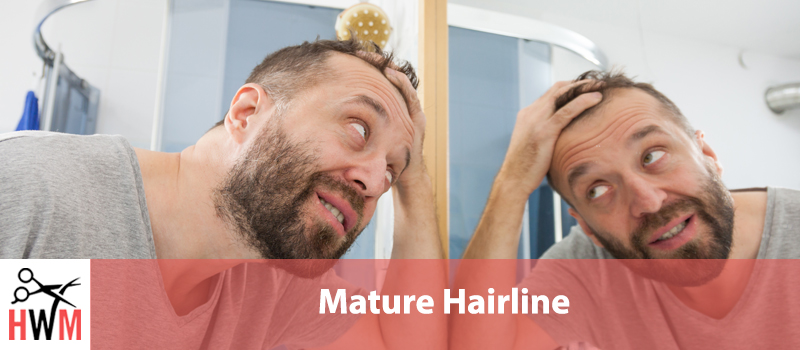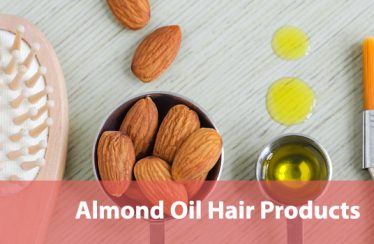Most men will look in the mirror at one point or another and experience a jolt of shock: their hairline has receded! But this doesn’t always mean that you’re going bald. Male pattern baldness is a different beast entirely.
A mature hairline is a natural experience for most men regardless of genetics. Such a development isn’t something to avoid or worry about. It’s a sign that you’ve left youth behind and are ready to take your place in the world.
Distinguishing a mature hairline from receding one can be tricky. In this guide, we’ll go over the common signs of each and help you deal with your new mature hairline. Even if your mature hairline is farther back than you like, it’s not the end of your style. Instead, it can be a new beginning.
- What is Your Frontal Hairline?
- What’s the Difference Between a Mature Hairline and a Receding Hairline?
- Does a Mature Hairline Indicate that You’re Going Bald?
- How Can You Deal with a Mature Hairline?
What is Your Frontal Hairline?
Simply put, your frontal hairline is the border area of your scalp past which hair will not grow. Your frontal hairline will likely have moderate shape differences that make it distinct from any other hairline. But overall your frontal hairline begins as a relatively uniform line that arcs from one side of your head to the other.
This hairline shape, with rounded corners, a low height, and a straight-across appearance is often called “juvenile”. No matter how good your genetics are, it’s not supposed to last forever. Your frontal hairline doesn’t always stay in one place. Lots of factors can combine to affect your frontal hairline and cause it to retreat with time.
When Does it Change Naturally?
Your frontal hairline will naturally recede between the ages of about 17-18 to 28-29. Essentially, your frontal hairline starts to recede as you grow out of your youthful years. While you may be genetically blessed enough to keep your juvenile hairline for your entire life, this affects only a small proportion of the population.
Most men will experience some hairline receding as they age. But this isn’t necessarily a loss of hair so much as it is a maturation of your final hairline. While hair loss is real and many men suffer from it, a mature hairline is distinct from a receding hairline.
In fact, hair experts do not consider hair maturation to be a form of male pattern baldness. Some mature hairlines may even end up looking slightly asymmetrical or awkward. But this still does not count as male pattern baldness or hair loss.
Furthermore, hair maturation is usually subtle, and many men do not notice it until it is in the final stages.
What’s the Difference Between a Mature Hairline and a Receding Hairline?
Let’s go over the primary differences between mature and receding hairlines so you can better identify which you are currently experiencing.
Mature Hairline
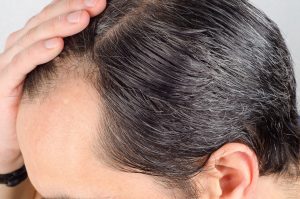
Mature hairlines can normally be distinguished with a simple measurement. Place your finger above the highest forehead wrinkle you can see. Your hairline should reach the edge of your finger’s width if you have a mature hairline.
If your hairline is much higher than this, you may be experiencing hair loss or recession rather than regular hairline maturation.
You should also investigate the corners of your hairline. These often recede during the hair maturation process. The corners of your hairline should be between one and 1.5 inches higher than the highest forehead wrinkles you can see.
A mature hairline is further distinguished by the quality of hair that you continue to produce and the presence of hair across your scalp. Mature hairlines do not indicate a weakening of the quality of your hair. Your mature hairline should also be as big as the rest of your hair rather than noticeably thinner.
Mature hairlines are much more uniform than hairlines that are affected by hair loss. You shouldn’t normally see much choppiness or asymmetry in a maturing hairline, although some slight irregularities are fine.
Hairline maturation also takes quite a long time to finalize. Men who experience male pattern baldness or hairline recession may see changes within a few months. But a mature hairline sometimes takes 10 years to fully form. Many men don’t get their mature hairline until their 30s.
What Causes a Mature Hairline?
A maturing hairline is not just a random fluke of nature. Specific hormonal reactions take place to change the way your hair develops and grows.
Specifically, dihydrotestosterone, or DHT, is the primary hormone that is responsible for your hair recession and male pattern baldness. DHT is a sex steroid or androgen hormone. It’s more powerful than the more well-known regular testosterone. But some DHT is necessary for a healthy male body.
As an androgen hormone, DHT is partially responsible for the biological characteristics that make your body masculine. DHT plays a role in the development of a deeper voice, as well as increased body hair and muscle mass. Unsurprisingly, your body gets saturated with DHT during puberty. This is why your body hair and other sexual characteristics change rapidly in your teenage years.
It’s also why children don’t usually go bald. One of the leading causes of male pattern baldness is an overabundance of DHT, which is almost impossible to experience as a child.
DHT is more powerful than testosterone because it attaches to the same hormonal receptor sites as regular testosterone. But it lasts for much longer and its effects linger far beyond what you would expect from regular testosterone.
Although men with a regular amount of DHT do not experience male pattern baldness, DHT still plays a role in the development of the mature hairline. It’s thought by some experts that long-term DHT exposure, like that which adult males experience for years, may cause some hair loss or hairline receding. Men with the appropriate amount of DHT see a slight reduction in their hairline rather than male pattern baldness.
Distinctive Shapes
Many men with maturing hairlines and up with distinctive shapes at the crown or crest of their heads. The most common shapes are “M” or “V”. M-shaped hairlines are defined by rounded curves that look more juvenile. Meanwhile, V-shaped hairlines have a sharper point and sides that are further receded than the tip of the hairline’s center.
Of the two, the V shape is much more common, though its intensity can vary greatly. There are also some men, such as Conan O-Brien, who aren’t suffering from male pattern baldness but who feature an extremely isolated V-shape section of hair. The resulting arrow of hair can give the impression of male pattern baldness even though it is likely just a fluke mature hairline.
Taking Care of Your Mature Hairline
Once you’ve identified your hairline’s nature, you should take some time to consider how you’ll care for it. Just because you don’t have a receding hairline now doesn’t mean you won’t acquire one in the future.
You need to take steps to take good care of your scalp and make sure that your hair follicles have everything they need to continue producing high-quality hair for the long term. This involves using high-quality shampoos and hair care products and preventing your hair from becoming too dry or irritated.
Using a moisturizing conditioner is always a great step. Furthermore, eating a healthy diet with plenty of vitamins and minerals is key for quality hair production. Your hair requires several minerals to retain strength and vigor. Poor diets don’t always have what your hair (and body) needs to be successful.
Will Hair Continue to Mature Throughout Life?
Your mature hairline does have a finishing point. But it’s impossible to determine where this finishing point is since everyone’s genetics are different.
The only way to tell if you’re going bald or still reaching your mature hairline terminus is to continually examine the progress your hairline makes. If it continues to show the signs that we described above, you likely have yet reached your final mature hairline even if it has been more than 10 years.
However, your mature hairline should never reach past your ears. Any hairline past this point has likely suffered from some male pattern baldness, even if your hairline has retained a uniform shape and you haven’t experienced hair thinning in other parts of your hair.
But if the signs you detect are more similar to those we described below, you may be suffering from male baldness and should take steps to correct it.
Receding Hairline
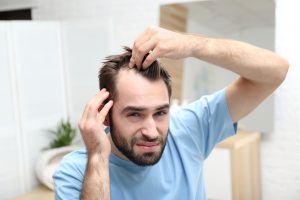
Receding hairlines are easy to distinguish from mature hairlines once you know what to look for.
While receding hairlines can start around the same time as mature hairlines, receding hairlines will often progress quite differently. Specifically, receding hairlines are usually affected by hair thinning and hair loss.
This is a result of your hair follicles not producing hair of a high enough quality to last for very long. If clumps for spots of hair begin to fall out sporadically, there’s a good chance that you are experiencing a receding hairline.
If your hair begins to thin in spots besides your hairline, you may be experiencing hair loss. It’s natural for the hair on your hairline to start to recede or fall back as you mature. But the rest of your hair should not change until you achieve seniority and begin to experience true baldness.
Hair recession taking place at spots other than your hairline normally indicates a high likelihood of male pattern baldness.
Furthermore, hair recession in a matter of months is not what you would experience from a maturing hairline. Rapid hair loss or recession is an indication of male pattern baldness or hair loss.
Recession at a few key spots are also signs that your hairline is not simply maturing. Recession on your temples that go far beyond the normal length of your hairline is a bad sign. Your temples are often the first spots to show the signals of recession due to their follicle construction and shape.
If you start to see bald spots at the crown of your head, it’s definitely a sign of hair thinning or male pattern baldness. The crown of your head is supposed to be so thick with hair that it’s normally the last spot to lose it from natural balding processes.
Another sign of a receding hairline can be clumps of hair falling out in short succession. Hair chunks that suddenly pull away when you rub your head are a surefire sign that you need to visit a dermatologist as soon as possible.
If your hair becomes suddenly hard to style or too thin to stand up on its own, it’s likely that your hair follicles are not providing those strands with enough nutrients to remain strong. Once again, this is a sign of male pattern baldness and you should get it investigated quickly.
What Causes a Receding Hairline?
Like a mature hairline, the primary cause of a receding hairline is DHT. The main difference between the two experiences is usually the amount of DHT flowing through your body.
Men with male pattern baldness are thought by many experts to have too much of the hormone flowing through their bodies. The overabundance of DHT causes your follicles to slowly miniaturize. As a result, the normal hair growth and nourishment phases that follicles normally experience become shortened.
This results in weaker and thinner hair. As DHT is continually produced, your hair follicles lose the time to sprout new hair strands entirely. This is what eventually causes male pattern baldness rather than just hair thinning.
Many men can accidentally induce male pattern baldness by using anabolic steroid drugs. These drugs are frequently used by bodybuilders to increase their muscle gains. But they may accidentally infuse their body with too much DHT and cause male pattern baldness in their own scalps as a result.
In addition to all these effects, some studies have shown that an overabundance of DHT can even lead to certain types of cancers. All in all, too much DHT is universally considered to be a bad thing.
However, your body may also be abnormally sensitive to DHT in general. In this scenario, even a normal amount of DHT is too much for your hair follicles and causes them to collapse. Men who are DHT sensitive don’t have too much of the hormone. Their bodies just can’t handle its effects.
But DHT isn’t the only reason you may be experiencing a receding hairline. Bacterial or fungal infections that dig into your scalp can stop your follicles from producing new hair strands. Similarly, excessively dry or irritated scalps will have a hard time producing strong, new hair.
Your hair follicles need to be in a healthy place to produce new hair. Keeping your scalp clean and uninfected is a great way to boost your odds of returning to your former hairline. You should also look into using a moisturizing conditioner to prevent dandruff from piling up and to keep your hair follicles nourished and protected.
Are There Ways to Stop a Receding Hairline?
If you are 100% sure that you are suffering from hair loss rather than a maturing hairline, there are a few steps you can take to lessen the effects that you experience.
For starters, you need to determine what is causing your hair loss. High DHT is usually the culprit but this is not always the case. It’s best to speak with your doctor before deciding on any treatment method. A dermatologist can examine your scalp and follicles and give you specific advice.
Once you have identified the causes of your hair loss, you can proceed to treatment. Some men end up using drugs like Minoxidil, which improves hair growth. Others will take treatments to reduce the levels of DHT that their bodies produce. Still more will focus on hair growth supplements or essential oils that can stimulate the follicles to produce stronger, healthier hair.
If you do take drugs that limit the amount of DHT in your body, keep in mind that this may affect hair growth and other parts of your body as well. Your body hair requires some level of DHT to continue to grow.
If your baldness as a result of DHT sensitivity, you may never be able to directly stop the effects of hair loss.
Does a Mature Hairline Indicate that You’re Going Bald?
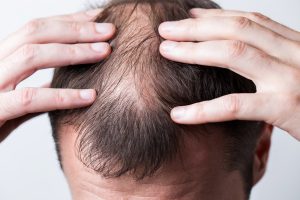
A mature hairline is a natural process that the vast majority (96% or so) of men experience throughout their lives. This doesn’t mean that you’ll definitely go bald, although many men eventually experience some hair loss or baldness as they reach senior years.
In fact, your predisposition for baldness at the end of your life is separate from your hairline maturation. Many men that experience deep hairline maturation will never grow fully bald before they die, and vice versa for men that keep their juvenile hairlines for most of their lives.
How Can You Deal with a Mature Hairline?
Many men learn to simply deal with their new hairline and incorporate it into their aesthetic. Mature hairlines can look wise and masculine in their own way. Indeed, many associate full head of hair with boyish behavior or charm.
But men well into their lives can often benefit from a different approach. Keep in mind that maturing hairlines are not necessarily less dense in terms of the number of hair strands per square inch. There’s just not quite as much thick hair at the front of their head as before.
That still leaves plenty of hair with which to play with. Many classic hairstyles are dependent on a mature hairline to look respectable. Consider the slicked-back style that was common several decades ago. This doesn’t work nearly as well with a full head of hair and a juvenile hairline. But getting a mature hairline will let you rock this style confidently.
Let’s go over some common hairstyles that men with mature hairlines can enjoy for many years to come.
Classic Cut
Sometimes it pays to stick with the classics. A regular hair cut with clean lines and enough density to keep your hair afloat, this style is suitable for men who like to look timeless.
Slicked-Back
This old-style cut is coming back into fashion. You have to grow your hair out to about medium length first, then use a styling product to slick it all back to your crown or further. Done correctly, you’ll look mature and stylish at the same time.
Angular Fringe
This newer haircut allows you to cover up your receding hairline by focusing many of your locks toward your forehead. Trim the sides short for extra style.
Textured Quiff
This popular haircut involves a sweeping your hair up to one side, then sweeping it upward. Use a holding gel or cream to keep your strands in place for longer and give your hair a fuller look.
Faux Hawk
This haircut involves raising your hair strands at your hairline up into a bold peak. It demonstrates your mature hairline for all to see, and that confidence can be attractive.
Curtain Fringe
Alternatively, you can let your hair locks and bangs fall low beneath your hairline to conceal it. It requires longer than average hair but is associated with many superstars or musical personalities.
Buzz Cut
If you want to evoke some military imagery, cut away most of your hair and demonstrate the shape of your skull. There’s no denying this style’s masculinity.
Ivy League
Use a fair amount of product and comb your hair almost all to one side. This old-school style is still displayed by many in the professional business sphere.
Flow
If you have medium length hair, sweep it back without using a looking gel. Your hair has to have a natural bounce to its texture, but the result is a fuller head of hair than many men can pull off.
Shape Up
This haircut needs the help of a skillful barber. It involves chiseling your hair into a rectangular shape and cutting the sides down to your skin. The result is a distinctive masculine shape.
